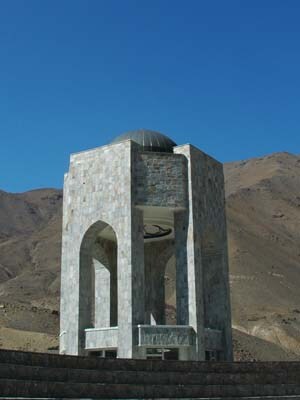
Kabul Diary - Road To Panjshir
Soviet armies and the Taliban were never able to gain control of these regions
There is a long row of eateries on both sides of the highway. Every shop has white cloth sacks hanging from strings in front. Paneer, Mohammad informs. Too early to eat. We go on. We pass a small town called Characar with lots of colourful three wheelers. We leave the highway that will go on to Kunduz and take a turn at Jabelseraj. Panjshir begins here. Panjshir means five lions. They are the Wali brothers or protectors of the valley. Legend has it that the brothers dammed the river in the valley overnight, saving the people from killer floods. We pass their mazaar. It is a small grove with the brothers graves.
Valley of Lions
We are headed to the grave of another lionised figure. Ahmad Shah Massoud is the national hero of Afghanistan. Officially. The Lion of Panjshir, as he was nicknamed, was the one man who had the ability to change the destiny of this war-torn country. He is revered. His pictures are everywhere. In shops, homes, on billboards and vehicles. At the gate of the school he went to.
The mountains surrounding the valley are bare and like mounds of loose rocks. Nothing grows on them. They resemble the mountains of Ladakh. People live in houses made of mud bricks and plastered with mud. Some are small but many are large. Some of them are built in the shape of forts. The place is idyllic. The beauty, however, hides what people here have gone through. Remembrance of war lie on the wayside. Rusting Soviet tanks and armoured vehicles lie in mangled heaps. We also pass a large graveyard of the killing machines. Huge cannons, silent and rusting. Soviet armies and the Taliban were never able to gain control of these regions. Commander Ahmad Shah Massoud’s Northern Alliance forces beat back every marauding army until September 9, 2001.

Two days before 9/11, Massoud was killed by a team of assassins posing as a television crew. People here believe Pakistan’s ISI orchestrated that hit. That is why there is plenty of resentment and anger against it. Massoud’s memorial has been funded by Iran, says Mohammad. It certainly looks Persian style. Tall narrow granite arches supporting a glass-and-metal dome. It is guarded by mountains on two sides and looks out to the valley on two. Mohammad points to the distance. Almost at the end of the valley on a hillock there is a small house. You can barely make out from this distance. 'That is Massoud’s house,' he says. Then he points to another house closer to the chirpy river. 'That is mine. It is just ten minutes from Massoud’s.' Mohammad is visibly proud that he is almost a neighbour of the late Commander. Everyone here is.

A strange coincidence happens. I send a text message to my artist friend Riyas Komu. Riyas had painted a series on Massoud some years ago. He calls. His excitement is palpable. "You won’t believe this. I am at Sahodaran Ayyappan’s house," Riyas says. Sahodaran Ayyappan was a widely respected social reformer and politician of Kerala in the middle of the last century. Two great leaders momentarily connected in a memorial phone call. Technology. Revolution.





